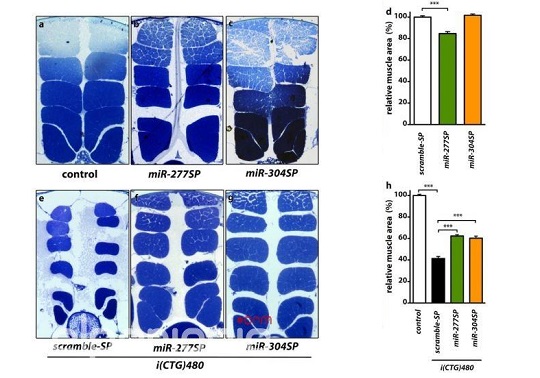
Researchers from the Universitat de València and INCLIVA have validated a novel genetic method to treat type 1 myotonic dystrophy. The method would consist of the therapeutic increase of the muscleblind gene by silencing another, two specific negative regulatory miRNAs. The possible application of the results of this research would allow reducing atrophy and other muscular manifestations derived from this pathology. The study, carried out in an animal model, has been published in the scientific journal 'Scientific Reports'.
The research has been carried out by researchers from the Translational Genomics group of the Department of Genetics and the Interdisciplinary Research Structure in Biotechnology and Medicine (ERI BIOTECMED) of the University of Valencia and the Health Research Institute of the Hospital Clínico de Valencia ( INCLIVE). The group is led by Rubén Artero, professor of Genetics at the Faculty of Biological Sciences. In Artero's words, the results obtained "are promising, since they open the door to analysis in cell and murine models, in order to increase the expression levels of this gene as a therapeutic target for the treatment of DM1".
Myotonic dystrophy type 1 (DMI1) is a rare inherited disease, which is genetically caused by the expansion of more than fifty copies of three nucleotides (CTG) in the DMPK gene (dystrophia myotonica-protein kinase). It is the most common type of muscular dystrophy in adults, occurring in one in every 8,000 births. It usually manifests between 15 and 35 years of age and is a disease that affects many organs: skeletal muscles, heart and central nervous system.
The methodology, validated in the vinegar fly (Drosophila melanogaster), attacks the disease at the molecular level by enhancing the muscleblind gene (which causes some of the symptoms of the disease such as atrophy, myotonia and heart disease) and the silencing of other genes, two types miRNAs. The latter are small molecules that in some cases have been altered in DM1 and whose function is to regulate gene expression.
The published work analyzes the effect that miRNA silencing would have, as a potential therapy to reduce and alleviate muscle problems that appear in the initial phase of this disease. In this way, for example, atrophy that leads to respiratory failure, the leading cause of death in DM1, could be treated.
The most characteristic symptoms of this disease are: difficulty in muscle relaxation (myotonia), loss of muscle mass (atrophy), systemic cardiac, respiratory, gastrointestinal, endocrine, cognitive or cataract manifestations.
Until now, all the therapeutic strategies tested in different animal models were focused on degrading the DMPK gene. However, none of these have reached the clinic. Given this, a little-explored alternative is the therapeutic modulation of gene expression, which seeks to increase or decrease the endogenous expression of a gene to alleviate a certain pathological state.
To carry out this study, focused on the pathology at the muscular level, model flies with 480 repetitions in muscle have been used as a consequence of the UAS / Gal4 expression system and the presence of a specific muscle driver, Myosin heavy chain (Mhc) -Gal4. These DM1 model flies were crossed with flies that express decoy or sponge constructs, that is, they express RNAs that contain many targets for a given miRNA, which generates a lack of function.
Thus, by crossing the two types, it was possible to reduce the function of miRNA specifically in muscle. Using this strategy, two genes have been identified, dme-miR-277 and dme-miR-304, regulators of muscleblind expression in Drosophila muscle. "The results have been surprising, since the DM1 animal model showed an increase in muscleblind levels compared to the controls by silencing dme-miR-277 and dme-miR-304 respectively", explains Estefanía Cerro, from the research group .
The efficacy of this strategy has also been demonstrated at the functional level, since the increase in muscleblind levels due to the silencing of dme-miR-277 and dme-miR-304 was capable of increasing the musculature of these flies. Likewise, the silencing of these two miRNAs improved the locomotor activity of the flies with myotonic dystrophy. Both at a physiological and functional level, the average survival of these insects has increased.
Access the original news.








